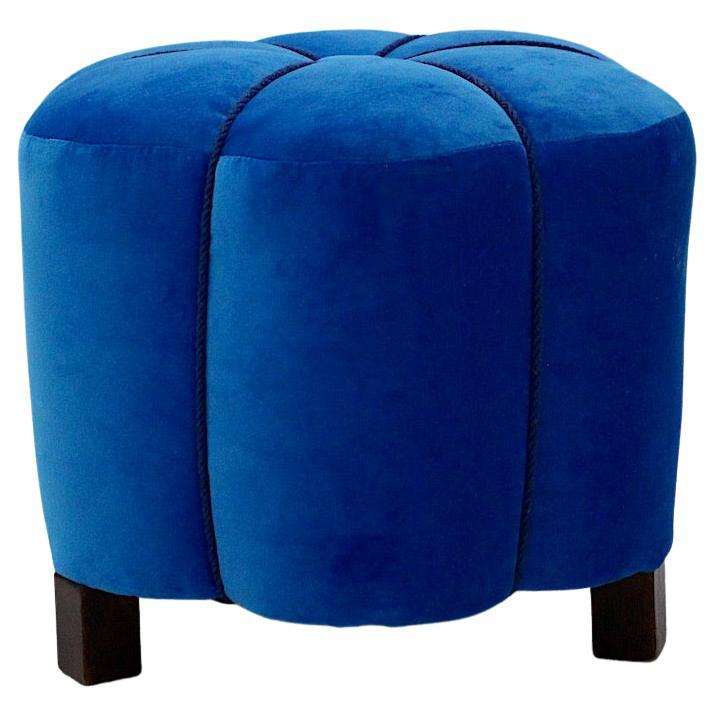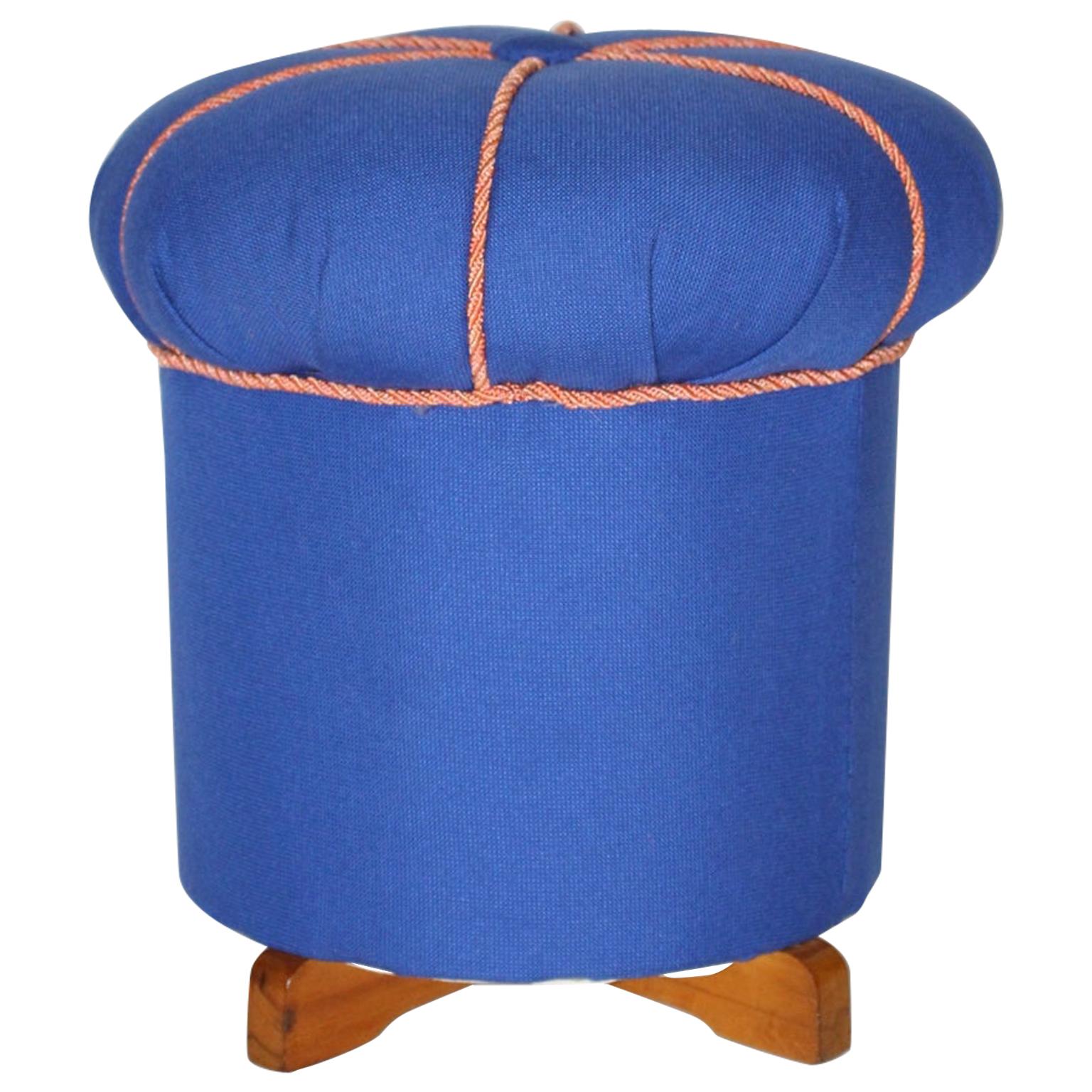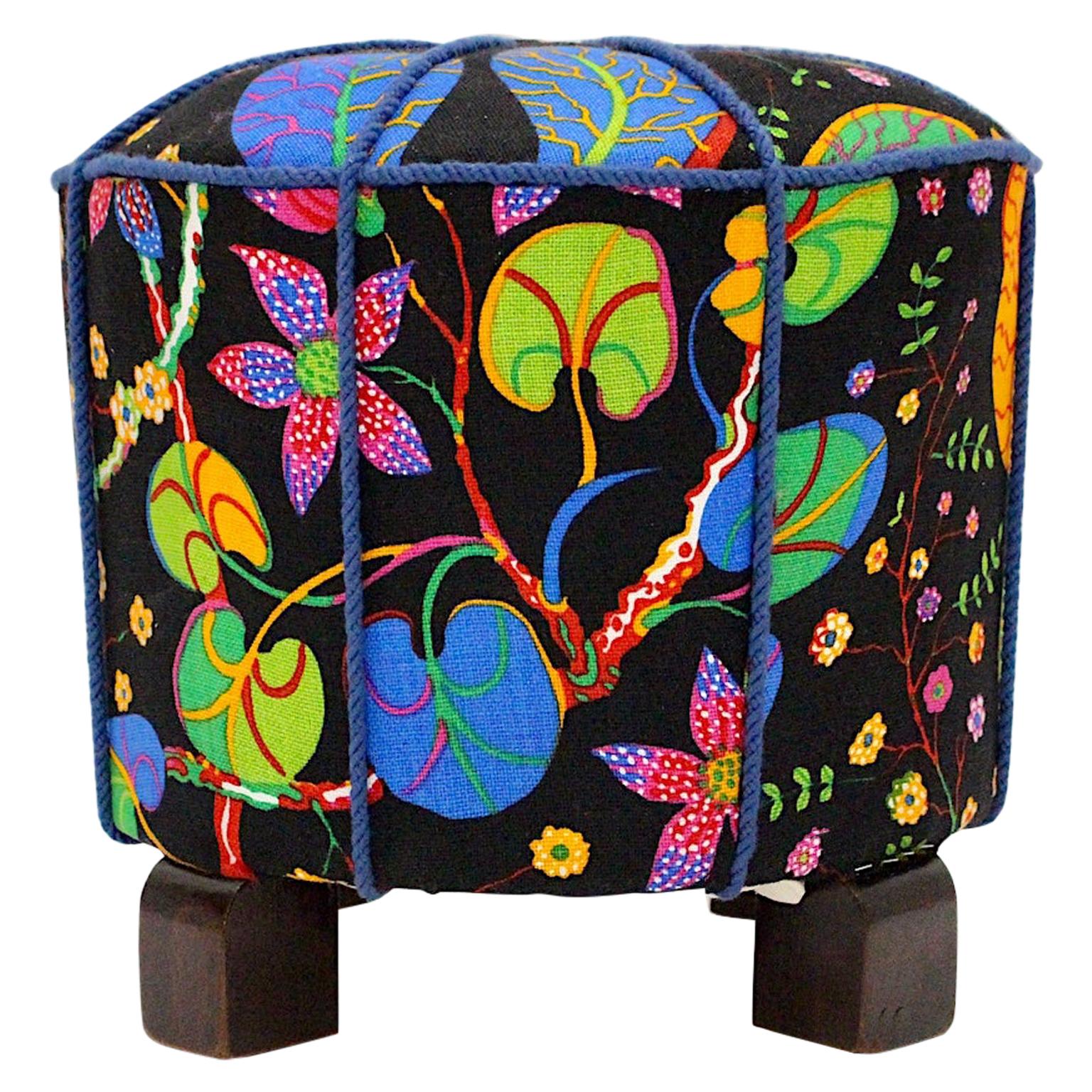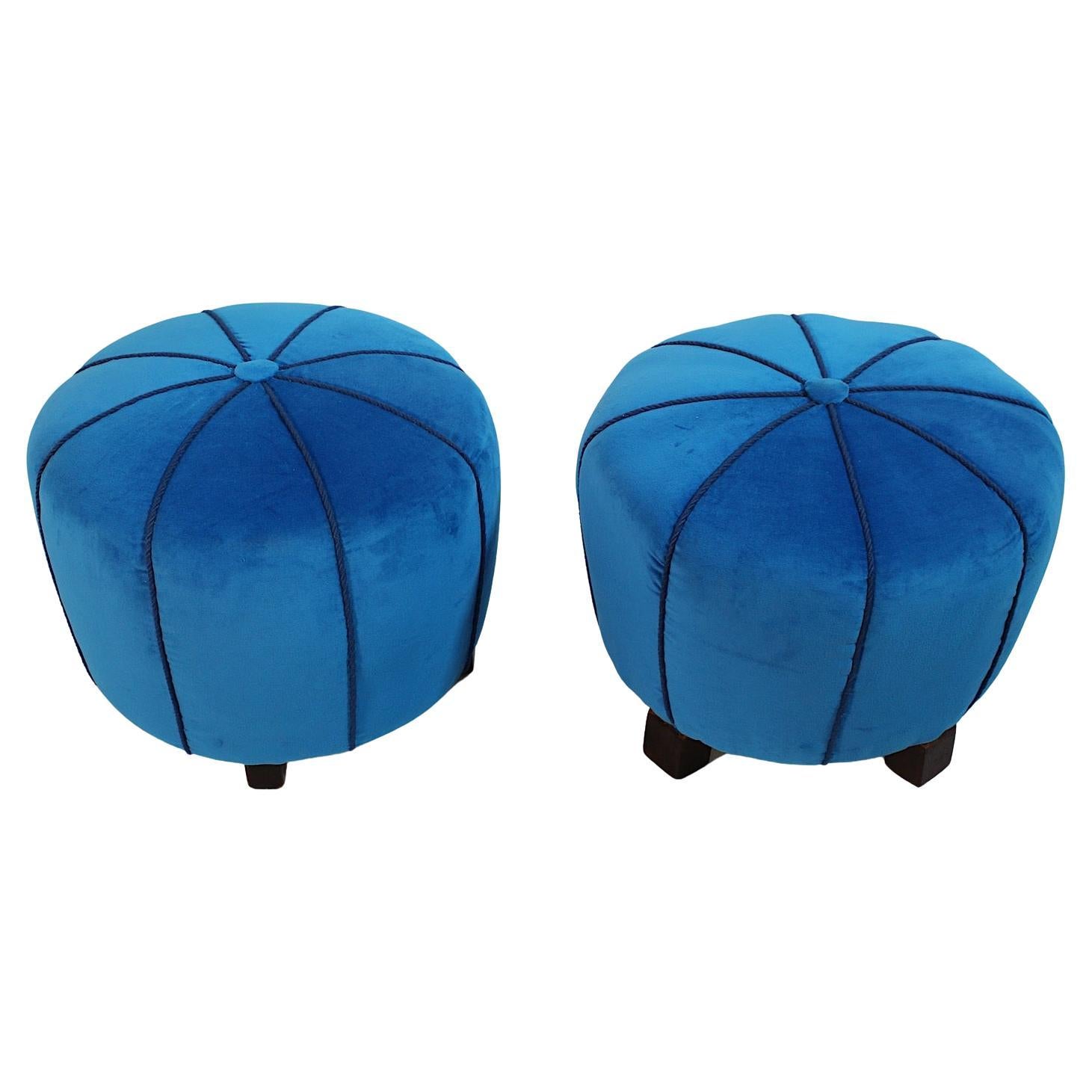Items Similar to Art Deco Vintage Pouf or Stool Stellar Blue Velvet Beech, 1930s, Austria
Want more images or videos?
Request additional images or videos from the seller
1 of 12
Art Deco Vintage Pouf or Stool Stellar Blue Velvet Beech, 1930s, Austria
About the Item
Art Deco vintage pouf or stool stellar - like from beech and velvet cover with blue cords 1930s Vienna.
An amazing vintage pouf or stool or footstool in beautiful stellar shape new covered with vivid blue velvet and blue cords.
This freestanding pouf in joyful lush color could be a powerful mix if you love an eclectic mix from furnitures from different periods and styles in unexpected combinations.
The stool works perfect with Contemporary interior as well as with Traditional or Rustic.
With a very lovely feel, this Art Deco pouf reflects the kind of easygoing chic from the Art Deco period.
It would also be perfect in a hospitality or corporate location as a boutique hotel or in your anteroom or clothing imperium.
Very good condition - ready to live
Approx. measures:
Diameter 42 cm
Height 39 cm.
- Dimensions:Height: 15.36 in (39 cm)Diameter: 16.54 in (42 cm)Seat Height: 15.36 in (39 cm)
- Style:Art Deco (Of the Period)
- Materials and Techniques:
- Period:
- Date of Manufacture:1930s
- Condition:Refinished. Wear consistent with age and use. new cover with blue velvet fabric.
- Seller Location:Vienna, AT
- Reference Number:1stDibs: LU1069830299612
About the Seller
5.0
Platinum Seller
These expertly vetted sellers are 1stDibs' most experienced sellers and are rated highest by our customers.
Established in 1970
1stDibs seller since 2014
425 sales on 1stDibs
Typical response time: 2 hours
- ShippingRetrieving quote...Ships From: Vienna, Austria
- Return PolicyA return for this item may be initiated within 3 days of delivery.
More From This SellerView All
- Art Deco Vintage Blue Velvet Beech Pouf Stool 1930s AustriaLocated in Vienna, ATArt Deco vintage pouf or stool stellar like with beech feet and blue velvet fabric cover, 1930s Austria. A stunning and joyful Art Deco pouf features new hand made electric blue velv...Category
Vintage 1930s Art Deco Stools
MaterialsFabric, Beech
- Art Deco Vintage Beech Pouf or Stool Josef Frank Fabric 1930s AustriaLocated in Vienna, ATArt Deco vintage pouf or stool or ottoman with three beech wood feet designed and manufactured 1930s Austria. An amazing stool covered with fresh and colorful textile fabric designed...Category
Vintage 1930s Austrian Art Deco Ottomans and Poufs
MaterialsBeech
- Art Deco Vintage Beech Blue Fabric Pouf Stool Austria 1930sLocated in Vienna, ATArt Deco vintage blue Pouf or ottoman or stool from blue fabric and beech 1930s Austria. The stool is reupholstered and covered with a denim blue fabric and pink cords and shows its ...Category
Vintage 1930s Austrian Art Deco Stools
MaterialsFabric, Upholstery, Beech
- Art Deco Blue Fabric Vintage Pouf or Stool, Austria, 1930sLocated in Vienna, ATThe presented vintage pouf features beech wood feet and was recently covered with electric blue textile fabric and pink cords. The pouf was designed and ...Category
Vintage 1930s Austrian Art Deco Ottomans and Poufs
MaterialsFabric, Upholstery, Beech
- Art Deco Vintage Beech Pouf or Stool with Josef Frank Fabric, 1930s, AustriaLocated in Vienna, ATArt Deco vintage pouf or stool with beech wooden feet, which is reupholstered and covered with gorgeous multicolored textile fabric. The textile fabric was designed in the 1930s by J...Category
Vintage 1930s Austrian Art Deco Ottomans and Poufs
MaterialsFabric, Upholstery, Beech
- Art Deco Vintage Beech Blue Velvet Pouf Stool Pair Duo circa 1930 AustriaLocated in Vienna, ATArt Deco vintage pair of poufs or stools circular shaped with stained beech feet 1930s Austria. An amazing pair of poufs or stools newly upholstered and covered with wonderful deep ...Category
Vintage 1930s Austrian Art Deco Stools
MaterialsFabric, Beech
You May Also Like
- 1930s Art Deco Stool, Footrest in Ebonized Walnut Restored, New UpholsteryLocated in Vigonza, PaduaArt Deco stool, footrest in ebonized walnut, restored, spring seat with white leatherette new upholstery. Measures cm: H 32, W 51, D 40.Category
Mid-20th Century Italian Art Deco Footstools
MaterialsLeather, Walnut
- Art Deco Tabouret by UP Zavody, 1930sBy Jindrich HalabalaLocated in Praha, CZ- Made by UP zavody in Czechoslovakia in 1930s - Made of wood, fabric - Original condition, sturdy and stabile. - Cleaned.Category
Vintage 1930s Czech Art Deco Stools
MaterialsFabric, Wood
- Art Deco Tabouret by UP Zavody, 1930sBy Jindrich HalabalaLocated in Praha, CZDesigned by Jindrich Halabala for UP Zavody. Made in Czechoslovakia Made of wood, fabric. Very good original condition.Category
Vintage 1930s Czech Art Deco Stools
MaterialsFabric, Wood
- Pair of French Art Déco Forged Iron Stools Offwhite-Colored Bouclé France 1930sLocated in Salzburg, ATPair of delicate forged Art Deco iron stools - offwhite colored Bouclé fabric France 1930-ies. The stools each stand on 3 legs that curve down slightly and elegantly, forming a volu...Category
Vintage 1930s French Art Deco Stools
MaterialsIron
- Art Deco Stool, Material Wood, Country France, 1930Located in Ciudad Autónoma Buenos Aires, CStools Art Deco. Material: wood You want to live in the golden years, this is the stool that your project needs. We have specialized in the sale of Art Deco and Art Nouveau style...Category
Vintage 1930s French Art Deco Stools
MaterialsWood
- Art Deco Stool, Material Iron, Country France, 1930Located in Ciudad Autónoma Buenos Aires, CStools Art Deco. Material: iron You want to live in the golden years, this is the stool that your project needs. We have specialized in the sale of Art Deco and Art Nouveau styles since 1982.If you have any questions we are at your disposal. Pushing the button that reads 'View All From Seller'. And you can see more objects to the style for sale. Why are there so many antiques in Argentina? In the 1880 – 1940 there was a grate wave of immigration encouraged by the periods of war that were taking place. 1st World War took place between 1914 and 1918 2nd World War took place between 1939 and 1945 The immigrants options were New York or Buenos Aires. Tickets were cheap and in Buenos Aires they were welcomed with open arms, as it was a country where everything was still to be done. Argentina was the country of new opportunities, labour was needed and religious freedom was assured, in many cases the of the family travel first until they were settled and then the rest of the family members join them. In the immigrant museum “Ellis Island Immigrant Building” in New York you can se the promotional posters of the boats that would take them to a new life. Between the years 1895 and 1896, Argentina had the highest DGP (gross domestic product) per capita in the world according to the Maddison Historical Statistics index, this situation arose due to the large amount of food being exported to European countries, which were at war. The Argentinean ships left the port of Buenos Aires with food, but they returned with furniture, clothes and construction elements, (it´s common to see this the old buildings of the historic neighbourhood of San Telmo, the beams with the inscription “Made in England)”, as well as many markets that were built in Buenos Aires, such us the San Telmo Market, whose structure was brought by ship and afterwards assembled in 900 Defensa Street. With the great influence of European immigrants living in the country, the children of the upper classes travelled to study in France, resulting in the inauguration of “La Maison Argentinienne”, on 27th of June 1928, in the international city of Paris, which hosted many Argentinians that were studying in Frace. It´s the fourth house to be built after France, Canada and Belgium, being the first Spanish-speaking one. Still in place today (17 Bd Jourdan, 75014, Paris, France). Many of the children of these wealthy families who attended international art exhibitions, museums and art courses abroad, took a keen interest in the European style. This is why Buenos Aires was at the time referred as “The Paris of South America”. Between the years 1890 and 1920 more than a hundred Palaces were built on Alvear Avenue the most exclusive avenue in Buenos Aires. Today some of these palaces have been transformed into museums, hotels and embassies. In the year 1936, the Kavanagh building was inaugurated, it was the tallest reinforced concrete building in South America. During 1994 the American Society of Civil Engineers distinguished it as an “international engineering milestone”, and it´s now considered a World Heritage of Modern Architecture. At the time was common to hire foreign architects such as Le Corbusier, who visited Buenos Aires/Argentina in 1929 and in 1948 he drew up the blueprints for a house built in La Plata City (which was declared a World Heritage Site). In 1947, the Hungarian architect Marcelo Breuer designed “Parador Ariston” in the seaside city of Mar del Plata. After an Argentinean student at Harvard University convinced him to come to Argentina. He worked on an urban development project in the Casa Amarilla, area of La Boca. The Ukrainian architect, Vladimiro Acosta, arrives in Argentina in 1928 and worked as an architect until que moved to Brazil. Antonio Bonet, a Spanish architect who worked with Le Corbusier in Paris, arrives in Argentina in 1937, where he carried out several architectural works and in 1938 designs the well-known BFK chair. Andres Kálnay, of Hungarian origin, made around 120 architectural masterpieces, among which the former Munich brewery stands out, he even made the furniture’s design. The German architect, Walter Gropius, director of the Bauhaus, lived in Argentina, where he wrote articles for “Sur” magazine and founded in Buenos Aires, an architectural firm with Franz Möller, who was also an architect, where he built two houses. At the same time several famous designers decided to immigrate to Argentina, among them we can find the well-known French designer, Jean-Michel Frank, who arrived in the country in 1940 and also worked for the Rockefeller family. Special pieces were made, which were sold exclusively in the country, such as the well-known German company “WMF”, who sold their products by catalogue, which were chosen by the ladies of high society in the list of wedding gifts, as well as the pieces designed by Christofle. The Swiss sculptor Alberto Giacometti, made special pieces for Argentinean mansions. In 1904 the first Jansen branch outside Paris was established in Buenos Aires, as the Argentinean clientele demanded a large amount of furniture, from the end of the 19th century to the mid-20th century. In 1970, the brand Rigolleau Argentina made pieces authorised by Lalique. The brands Maple and Thompson also set up shop in the country. The French plastic artist, Marcel Duchamp moved to Argentina in 1918-1919. Glass signed Gallé, Charder, Leverre, Schneider, Muller and other French firms. They were bought in flower shops and were given to ladies with beautiful floral arrangements. Some furniture manufacturers travelled to international fairs and bough the patterns to produce the furniture in Argentina, such as the furniture firm Englander and Bonta, who bought the patterns ins Italy. It is worth mentioning that in Argentina we have the largest community of Italians outside...Category
Vintage 1930s French Art Deco Stools
MaterialsIron
Recently Viewed
View AllMore Ways To Browse
Blue Velvet Stool
Velvet Austrian
Stool From The 1930s
Rustic Vintage Stool
Blue Velvet Pouf
Stellar Vintage
Vintage Velvet Stool
Art Deco Upholstery Poufs
Art Deco Wood Footstools
1930s Wood Footstools
Eclectic Vintage Clothing
Blue Velvet Footstool
1930s Upholstery Footstools
Austrian Beech Footstools
Art Deco Hardwood Footstools
Screw Top Stool
Brass Library Light
Leather And Steel Counter Stool





